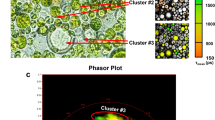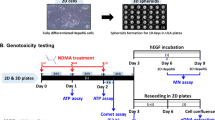Abstract
The recently described increase in DNA strand breaks of cultured human diploid fibroblasts after intermittent exposure to extremely-low-frequency electromagnetic fields (ELF-EMF) of more than about 70 µT ELF-EMF is difficult to explain by a direct induction of covalent bond disruption. Therefore the hypothesis has been tested that ELF-EMF-induced DNA strand breaks might be mediated by cellular processes that cause alteration of the intracellular concentration of free calcium ([Ca2+]i) and/or the membrane potential (ΔΨm). [Ca2+]i was determined by the ratiometric fura-2 technique. Changes in ΔΨm were assessed by using the potential-dependent lipophilic cationic probe JC-1. Human fibroblasts were exposed to intermittent ELF-EMF (50 Hz, 1000 µT). Although exposure of fiboblasts to ELF-EMF resulted in a highly significant increase in DNA strand breaks as determined by the comet assay, no effect on JC-1 fluorescence emission or on [Ca2+]i has been observed when comparing exposed with sham-exposed cells. Therefore, it is suggested that ELF-EMF-induced DNA strand breaks are unlikely to be caused by intracellular changes that affect [Ca2+]i and/or ΔΨm.




Similar content being viewed by others
References
Ivancsits S, Diem E, Pilger A, Rüdiger HW, Jahn O (2002) Induction of DNA strand breaks by intermittent exposure to extremely-low-frequency electromagnetic fields in human diploid fibroblasts. Mutat Res 519:1–13
Walleczek J (1992) Electromagnetic field effects on cells of the immune system: the role of calcium signaling. FASEB J 6:3177–3185
Salvioli S, Bonafé M, Capri M, Monti D, Franceschi C (2001) Mitochondria, aging and longevity—a new perspective. FEBS Lett 492:9–13
Robb-Gaspers LD, Burnett P, Rutter GA, Denton RM, Rizzuto R, Thomas AP (1998) Integrating cytosolic calcium signals into mitochondrial metabolic responses. EMBO J 17:4987–5000
Shigenaga MK, Hagen TM, Ames BN (1994) Oxidative damage and mitochondrial decay in aging. Proc Natl Acad Sci USA 91:10771–10778
Petit PX, Susin SA, Zamzami N, Mignotte B, Kroemer G (1996) Mitochondria and programmed cell death: back to the future. FEBS Lett 396:7–13
Satoh T, Enokido Y, Aoshima H, Uchiyama Y, Hatanaka H (1997) Changes in mitochondrial membrane potential during oxidative-stress induced apoptosis in PC12 cells. J Neurosci Res 50:413–420
Salvioli S, Barbi C, Dobrucki J et al. (2000) Opposite role of changes in mitochondrial membrane potential in different apoptotic processes. FEBS Lett 469:186–190
Lyng FM, Seymour CB, Mothersill C (2000) Production of a signal by irradiated cells which leads to a response in unirradiated cells characteristic of initiation of apoptosis. Br J Cancer 83:1223–1230
Lin Y, Brown L, Hedley DW, Barber DL, Benchimol S (2002) The death-promoting activity of p53 can be inhibited by distinct signaling pathways. Blood 100:3990–4000
Vayssière JL, Petit PX, Risler Y, Mignotte B (1994) Commitment to apoptosis is associated with changes in mitochondrial biogenesis and activity in cell lines conditionally immortalized with simian virus 40. Proc Natl Acad Sci USA 91:11752–11756
Akerman KEO (1978) Changes in membrane potential during calcium ion influx and efflux across the mitochondrial membrane. Biochim Biophys Acta 502:359–366
Lee I, Bender E, Kadenbach B (2002) Control of mitochondrial membrane potential and ROS formation by reversible phosphorylation of cytochrome c oxidase. Mol Cell Biochem 234–235:63–70
Cossarizza A, Baccarani-Contri M, Kalashnikova G, Franceschi C (1993) A new method for the cytofluorimetric analysis of mitochondrial membrane potential using the J-aggregate forming lipophilic cation 5,5’,6,6’-tetrachloro-1,1’,3,3’-tetraethylbenzimidazolcarbocyanine iodide (JC-1). Biochem Biophys Res Comm 197:40–45
Salvioli S, Ardizzoni A, Franceschi C, Cossarizza A (1997) JC-1, but not DiOC6(3) or rhodamine 123, is a reliable fluorescent probe to assess delta psi changes in intact cells: implications for studies on mitochondrial functionality during apoptosis. FEBS Lett 411:77–82
Grynkiewicz G, Poenie M, Tsien RY (1985) A new generation of Ca2+ indicators with greatly improved fluorescence properties. J Biol Chem 260:3440–3450
Smiley ST, Reers M, Mottola-Hartshorn C et al. (1991) Intracellular heterogeneity in mitochondrial membrane potentials revealed by a J-aggregate-forming lipophilic cation JC-1. Proc Natl Acad Sci USA 88:3671–3675
Östling O, Johanson KJ (1984) Microelectrophoretic study of radiation-induced DNA damages in individual mammalian cells. Biochem Biophys Res Commun 123:291–298
Singh NP, McCoy MT, Tice RR, Schneider EL (1988) A simple technique for quantitation of low levels of DNA damage in individual cells. Exp Cell Res 175:184–191
Singh NP, Tice RR, Stephens RE, Schneider EL (1991) A microgel electrophoresis technique for direct quantitation of DNA damage and repair in individual fibroblast cultured on microscope slides. Mutat Res 252:289–296
Tsong TY (1992) Molecular recognition and processing of periodic signals in cells: study of activation of membrane ATPases by alternating electric fields. Biochim Biophys Acta 1113:53–70
Blank M (1992) Na,K-ATPase function in alternating electric fields. FASEB J 6:2434–2438
Lindström E, Lindström P, Berglund A, Mild KH, Lundgren E (1993) Intracellular calcium oscillations induced in a T-cell line by a weak 50 Hz magnetic field. J Cell Physiol 156:395–398
Kenny JS, Kisaalita WS, Rowland G, Thai C, Foutz T (1997) Quantitative study of calcium uptake by tumorigenic bone (TE-85) and neuroblastoma x glioma (NG108–15) cells exposed to extremely-low-frequency (ELF) electric fields. FEBS Lett 414:343–348
Cho MR, Thatte HS, Silvia MT, Golan DE (1999) Transmembrane calcium influx induced by ac electric fields. FASEB J 13:677–683
Jajte J, Zmyslony M, Palus J, Dziubaltowska E, Rajkowska E (2001) Protective effect of melatonin against in vitro iron ions and 7 mT 50 Hz magnetic field-induced DNA damage in rat lymphocytes. Mutat Res 483:57–64
Lai H, Singh NP (1997) Melatonin and N-tert-butyl-alpha-phenylnitrone block 60 Hz magnetic field-induced DNA single and double strand breaks in rat brain cells. J Pineal Res 22:152–162
Li SH, Chow KC (2001) Magnetic field exposure induces DNA degradation. Biochem Biophys Res Commun 280:1385–1388
Lai H, Singh NP (2004) Magnetic field-induced DNA strand breaks in brain cells of the rat. Environ Health Perspect 112:687–694
Acknowledgements
This study was supported by a grant of the European Union under the programme “Quality of Life and Management of Living Resources”, Key Action 4 “Environment and Health”: QLK4-CT-1999–01574.
Author information
Authors and Affiliations
Corresponding author
Rights and permissions
About this article
Cite this article
Pilger, A., Ivancsits, S., Diem, E. et al. No effects of intermittent 50 Hz EMF on cytoplasmic free calcium and on the mitochondrial membrane potential in human diploid fibroblasts. Radiat Environ Biophys 43, 203–207 (2004). https://doi.org/10.1007/s00411-004-0252-9
Received:
Accepted:
Published:
Issue Date:
DOI: https://doi.org/10.1007/s00411-004-0252-9




